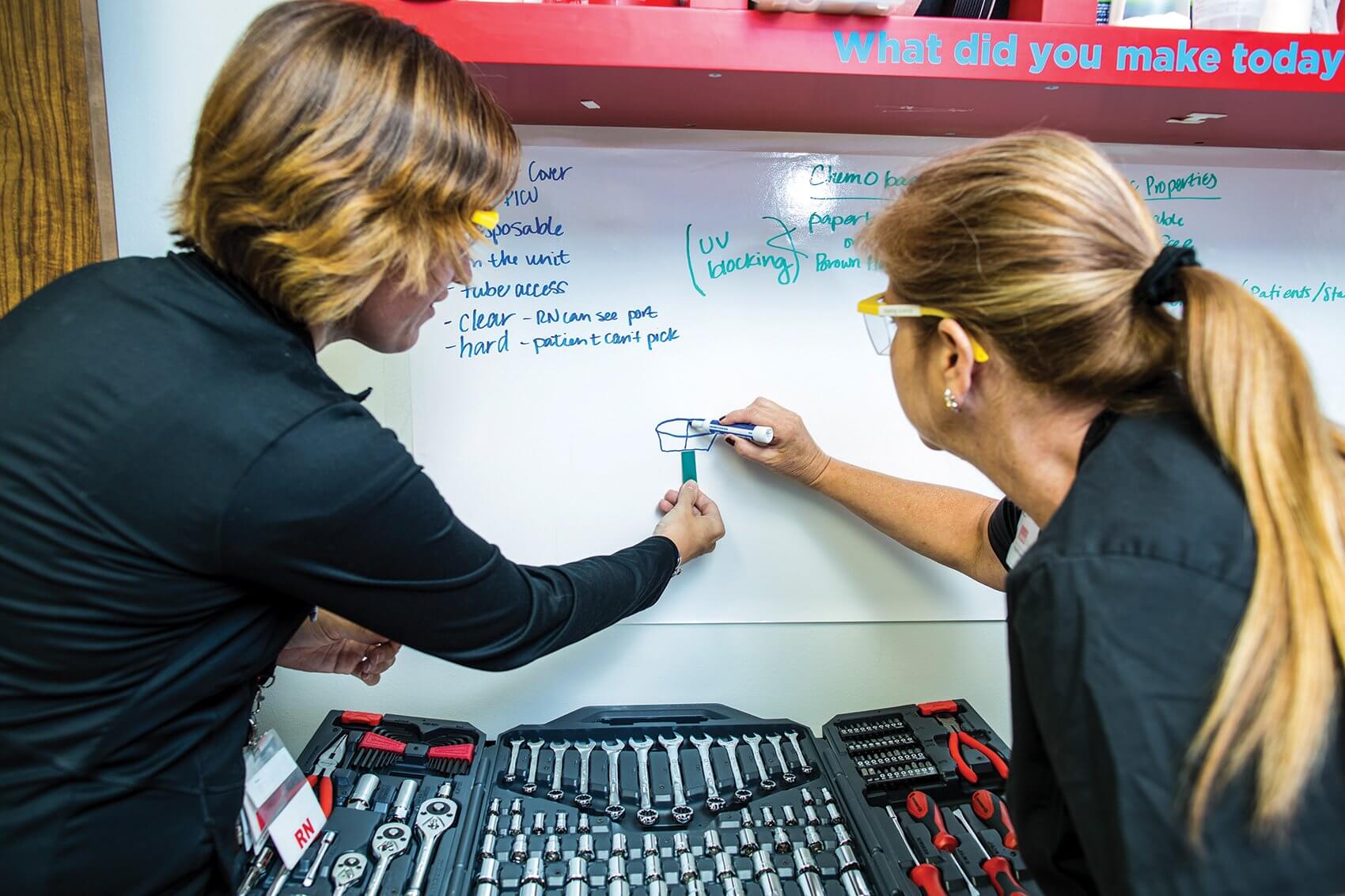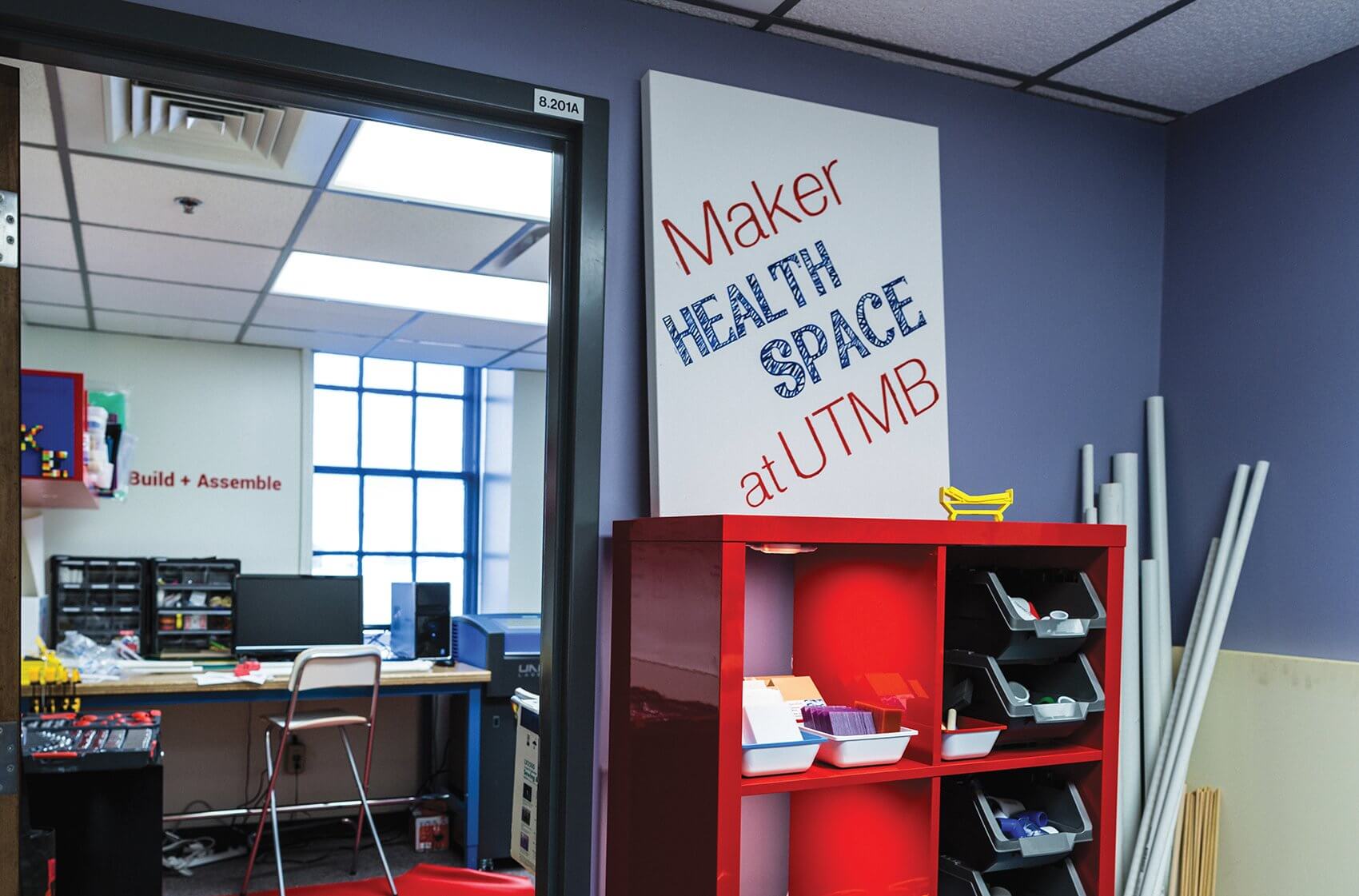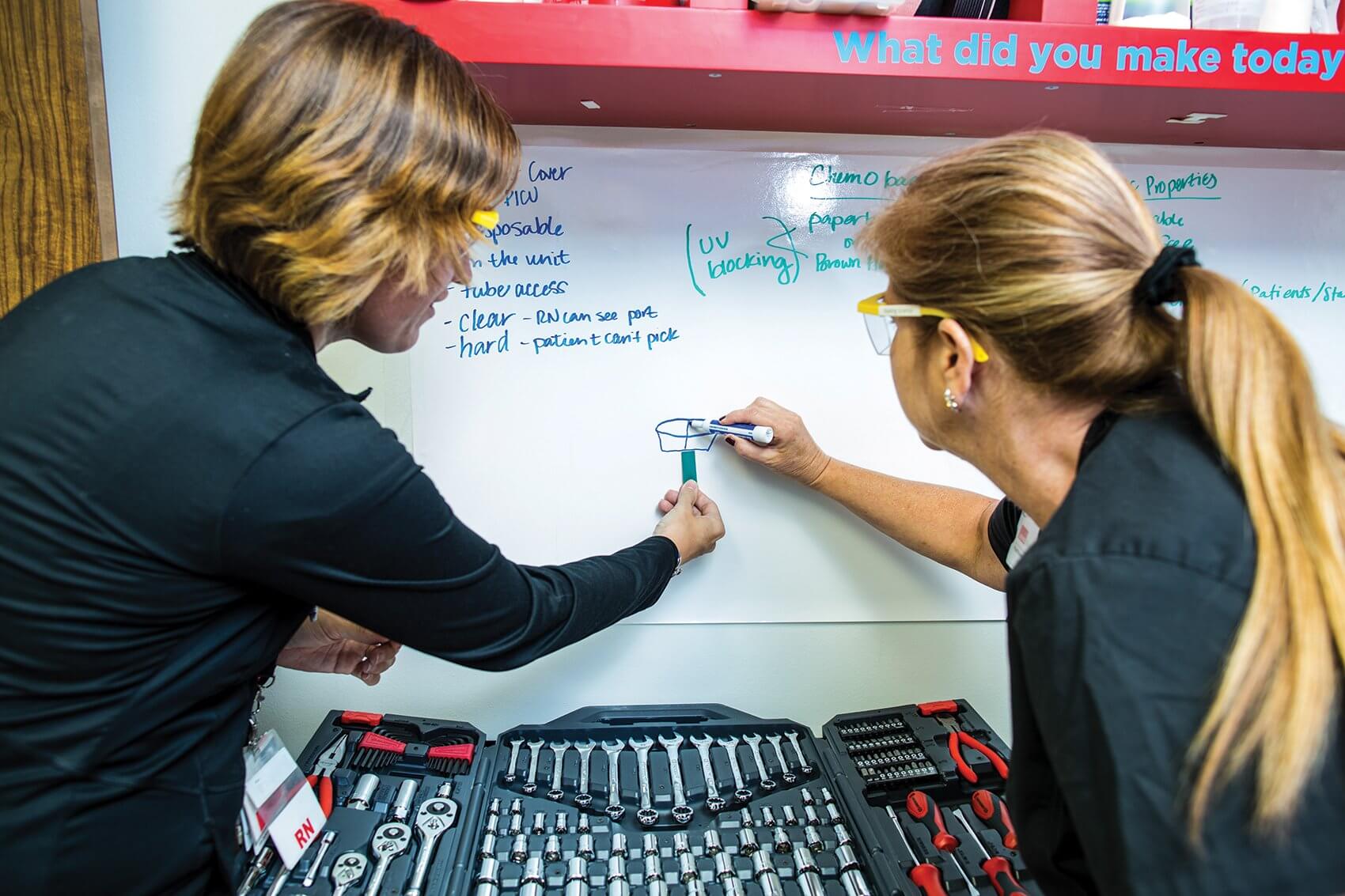Innovations in the Making

Nestled inside the John Sealy Hospital at The University of Texas Medical Branch at Galveston (UTMB), nurses and health care professionals are tinkering away. Safety goggles rest on shelves next to engineering manuals, Velcro, zip ties and multipurpose plastic coating. A pristine white cube harbors a 3-D printer while a sewing machine, laser cutter and soldering iron add to the illusion of a grown-up’s designer playground. Crisp red letters stamped on the wall neatly delineate different workstations, from “Digital Design and Fabrication” to an area dubbed “Build and Assemble,” fully stocked with enough wrenches and power tools to fulfill any workman’s wildest whim.
An elegant hybrid of high-tech prototyping equipment, traditional workshop and design tools, and an everyday supply closet, the MakerHealth Space at UTMB—the first permanent makerspace in the country for health care providers—is poised to change the way we think about innovation in health care. The result of a unified effort by MakerNurse and UTMB, with the support of the Robert Wood Johnson Foundation, the MakerHealth Space will empower nurses and other medical staff to bring their ideas for improving care to life—and spread their innovations throughout the health care system.
“Everybody is looking for ways to do things more efficiently in health care,” said David Marshall, head of nursing at UTMB. “We think it makes sense to have the space in the hospital near where patient care is provided. This way, if there is some time during the day where providers have an idea in mind, they can go up to the space and explore their idea. We think that one person’s innovation could inspire others, so as we catalogue what people come up with, we want to publish those for others to see.”
Over the past two years, MakerNurse—which has launched mobile makerspaces in several hospitals and nursing schools across the country—has uncovered resourceful nurses using everyday materials to improve upon and create new tools and devices that catalyze better ways of caring for patients: cough pillows composed of hospital blankets wrapped in medical tape; tactile patient call buttons using tongue depressors and pieces of silk; popsicle drip cups to keep pediatric patients from making a mess of things. These simple solutions to practical problems demonstrate the blank canvas for innovation that exists in hospitals throughout the country.
“Maker spaces are on the rise,” said Anna Young, co-founder of MakerNurse. “You’re seeing them in schools, libraries and communities, so we’re at a time where prototyping tools and materials have become more affordable and the software that interfaces with them is more approachable. You don’t need to be an engineer and have an engineering degree to learn how to rapid prototype and design.
“What’s unique about the MakerHealth Space at UTMB is putting those tools in the context of a health care system that’s providing basic care,” she added. “When you walk into the space, it’s a combination of rapid prototyping tools and materials that you would see in a traditional workshop mixed in with the hospital supply closet.”
Medical staff can use the makerspace to prototype a new tool, upgrade an existing hospital device—such as adding a sensor to a take-home pill bottle to monitor use—or to customize materials for individual patients. All devices made in the makerspace are sterilized and tested through a quality improvement or institutional review board study before being used on the hospital floor. Located on a patient floor of the John Sealy Hospital, the MakerHealth Space is well situated to ensure that ingenuity and making become embedded in the care delivery process.
“We wanted to make certain that the space was in an accessible location for those staff who work with our patients,” Marshall said. “Space like that is at a premium in pretty much any health care organization, but we found 120 square feet of temporary workspace so that we could get the space up and running as quickly as possible, and really start to fabricate and prototype.” UTMB is in the process of finalizing the construction of a new, larger workshop space in the Jennie Sealy Hospital. They’ll be relocating in early 2016.
Closer to the bedside than conventional engineering labs and most other medical professionals, nurses are uniquely positioned to spot suboptimal technology and design breakthrough solutions to improve care. Too often, their ideas float nebulously through the backs of their minds or remain scribbled on a napkin. The makerspace at UTMB provides nurses with direct access to the tools, resources, and expertise to build prototypes and test their ideas.
“I think nurses have been innovating ever since Florence Nightingale went over to Crimea to take care of the wounded soldiers there,” Marshall said. “While it’s probably waxed and waned throughout the history of the profession, nurses have been consistently coming up with ideas about how we can make patients more comfortable, safer, and enable caregivers to be more efficient.”
“Nurses are at the forefront of care, really,” Young added. “They have the most contact with patients, both while the patients are being diagnosed and receiving treatment and then even when they’re discharged. Making and prototyping are all about these small, incremental changes that happen at the individual level, so nurses are a really well positioned group to start with. And they’re already doing it, which is what’s so exciting—they’re just too busy to tell anybody about it.”
Nurses like Jason Sheaffer, who works in UTMB’s Blocker Burn Unit, have already seized the opportunity presented by the MakerHealth Space.
“Essentially, we’re trying to use simple tools to make better use of the resources that we have,” he noted. “The engineers at MakerNurse have given us the chance to come up with solutions. That’s exactly what I did—I came up here, told them what I was looking at, and we put together a design and built the device.”
In the Blocker Burn Unit, patients who have sustained serious burns lay down on a table, where they’re washed via an extendable hose that dispenses filtered water. While that works the majority of the time, every now and then Sheaffer and his colleagues encounter a patient who has suffered a chemical injury—those patients need to be irrigated for a very long time, until the chemical is totally washed out. This necessitates a nurse or technician holding the water hose for hours at a time.
“The staff that work back here are more than just the people who wash patients—they’re critical care nurses,” Sheaffer said. “I wanted to come up with a simple irrigation system that would attach to the existing water source and wash the whole patient, all at once, in certain targeted areas. That would free up the hands of the staff to do other things in critical care.”
A testament to pragmatic ingenuity and resourceful thinking, Sheaffer’s contraption is strikingly simple: constructed out of PVC piping, it uses custom-made clips to secure to the edge of the table, while a 3-D printed connector hooks onto the unit’s water source. Lightweight and completely customizable, it uses three filtered shower heads—the standard of care in the unit—to direct the water exactly where it needs to be dispensed.
While spearheaded by nurses at UTMB, the makerspace will be open to all medical staff and health professions students. Nurses also envision themselves working with patients and caregivers to create personalized devices that work for them. As an outlet for creative medical professionals who problem solve for a living, the MakerHealth Space at UTMB will continue to enable them to take their ideas from conception to reality—and implement them throughout their daily practice.
“The process of nursing incorporates both an art and a science to it,” Sheaffer said. “There’s definitely a science to the job, especially the components that we’re taught in school and what we learn about health and assessment, but there’s also an art to it that can’t be taught. It can only be figured out and experienced. Being able to sit there and figure out what’s going to work for that exact patient—and then having the tools and resources at MakerHealth to bring it into reality—is a great way to leverage both sides of the profession.”






